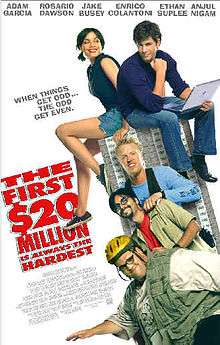The First $20 Million Is Always the Hardest
| The First $20 Million Is Always the Hardest | |
|---|---|
 Theatrical release poster | |
| Directed by | Mick Jackson |
| Produced by | Trevor Albert |
| Written by |
Po Bronson (book) Jon Favreau Gary Tieche |
| Starring |
Adam Garcia Rosario Dawson Jake Busey Enrico Colantoni Ethan Suplee Anjul Nigam Gregory Jbara |
| Music by | Marco Beltrami |
| Cinematography | Ronald V. Garcia |
| Edited by | Don Brochu |
| Distributed by | 20th Century Fox |
Release dates | June 28, 2002 (U.S.) |
Running time | 105 min. |
| Language | English |
| Budget | $17,000,000[1] |
| Box office | $5,491[2] |
The First $20 Million Is Always the Hardest is a 2002 film based on a novel by technology-culture writer Po Bronson. The film stars Adam Garcia.
Plot
Garcia stars as Andy Kasper, a man who gives up his cushy marketing job to do something more fulfilling. He gets himself hired at LaHonda Research Institute where Francis Benoit (Enrico Colantoni) assigns him to design the PC99, a PC to sell for $99. He moves into a run-down apartment building where he meets his lovely artist next-door neighbor Alisa (Rosario Dawson), and puts together a team of unassigned employees: Salman Fard (Anjul Nigam), a short, foreign man with an accent who is hacking into CIA files when Andy meets him; Curtis "Tiny" Russell (Ethan Suplee), a massively obese, anthropophobic man; and Darrell (Jake Busey), a tall, blond, pierced, scary, germophobic, deep-voiced man with personal space issues who regularly refers to himself in the third person.
The team finds many non-essential parts but cannot come close to the $99 mark. It is Salman's idea to put all the software on the internet, eliminating the need for a hard drive, RAM, a CD-ROM drive, a floppy drive, and anything that holds information. The computer has been reduced to a microprocessor, a monitor, a mouse, a keyboard, and the internet, but it is still too expensive. Having seen the rest of his team watching a hologram of an attractive lady the day before, in a dream Andy is inspired to eliminate the monitor in favor of the cheaper holographic projector. The last few hundred dollars comes off when Darrell suggests using virtual reality gloves in place of a mouse and keyboard. Tiny then writes a "hypnotizer" code to link the gloves, the projector, and the internet, and they're done.
But immediately before he finishes, the whole team (except for Tiny, who is still writing the code) quits LaHonda after being told that there are no more funds for their project, but sign a non-exclusive patent waiver, meaning that LaHonda will share the patent rights to any technology they had developed up to that point. After leaving LaHonda, they pitch their product to numerous companies, but do not get accepted, mainly because:
- the prototype emagi (electronic magic) as it was now called, was ugly, and
- something always seemed to go wrong during the demonstration of their product.
They have almost given up hope, when in comes the lovely next-door neighbor Alisa again, whose relationship with Andy has been growing steadily. She improves its look, and when called back by an executive from one of the companies they had pitched to, to whom they had said that their design teams were working on a cosmetic model that would be ready in a couple of days when she commented, "You haven't given much thought to the look of it." After meeting with her, they agree to give her 51% of their company in exchange for getting their product manufactured and for getting Andy's Porsche bought back, which he had had to sell in order to raise money to build a new emagi after leaving LaHonda. Unfortunately, she then sells the patent rights to the emagi to Francis Benoit, who plans to sell the emagi at $999 a piece and reap a huge profit. The team interrupts the meeting in which Benoit is going to introduce the emagi to the world and introduces an even newer computer he and his team developed and manufactured at LaHonda, which was in a state of disaster when they arrived. It was a small silver tube that projected a hologram and lasers which would detect where the hands were, eliminating the need even for virtual reality gloves. Also, Andy reminds Benoit of the non-exclusive patent waiver, which had even been Benoit's idea in the first place.
Production
The film was made by 20th Century Fox at the cost of $17 million and is sometimes shown on HBO. The video and DVD received limited release in New York and Los Angeles. Its domestic gross was just $5,491, making it one of the greatest flops in movie history.
Po Bronson played a cameo role in the film as one of many tuba players living in the same building as the main character. The tentative title for this movie during test screenings was "The Big Idea".
References
- ↑ "Marco Beltrami: Film music credits". Freebase. Retrieved 2010-09-13.
- ↑ "The First $20 Million... (2002)". Box Office Mojo. Retrieved 2010-09-13.